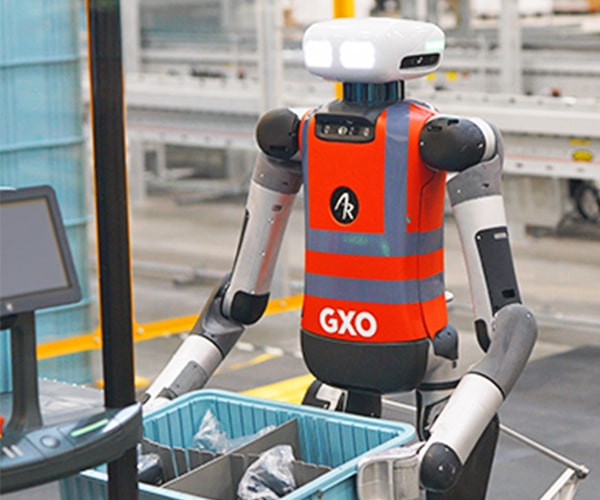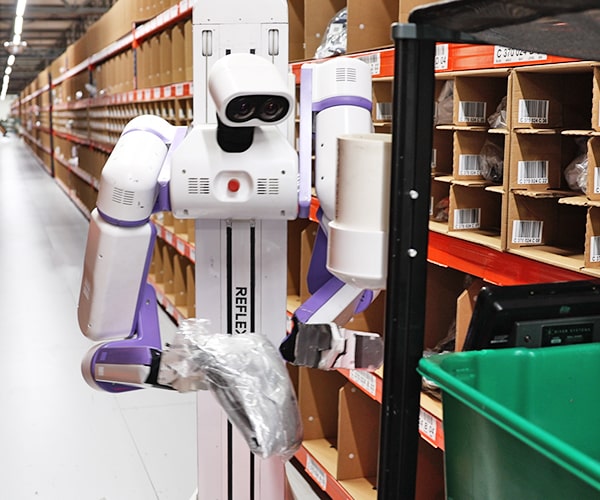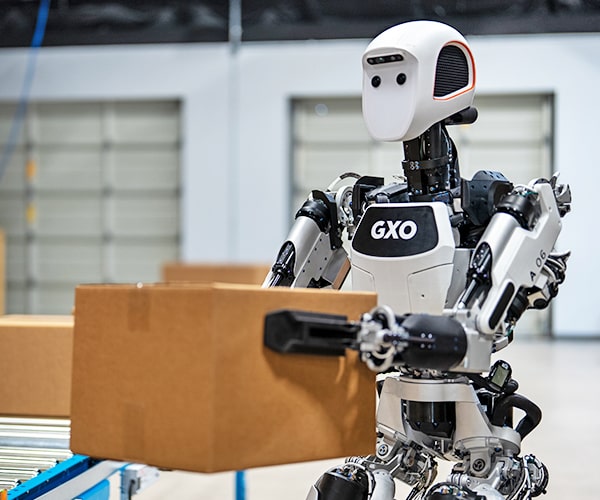Blog
Shaping the supply chain of tomorrow

As the industry leader in automated logistics solutions, GXO is among the first to collaborate with cutting edge robotics developers to explore the game-changing potential of humanoid technology in the warehouse.
The power and potential of humanoid robots
Over the past year, we’ve trialed three humanoid prototypes and became the first logistics provider to deploy this technology in a live operating facility. We see potential for humanoid robotics to improve efficiency across a wide variety of use cases in the fulfillment center, creating capacity for our customers while replacing human effort on repetitive tasks and reducing risk of injury.
The power of this technology is the paradigm shift it will drive on a variety of levels.
First, we are in the midst of a global demographic shift, as growth in the working age population continues to decline. The logistics industry, like many others, is experiencing a labor shortage, particularly in roles that involve repetitive or labor-intensive tasks. To keep pace with the demand for workers, faster turnaround times and greater accuracy, we see a future for the industry in which humanoid robots work alongside humans. As the robots perform physically demanding and repetitive tasks – with little, if any, integration requirements – team members within the warehouse will assume different roles, while achieving greater operational continuity and reliability.
Second, many of today’s automation solutions were originally developed to solve discrete problems, as opposed to acting as a multi-purpose application. The flexibility of humanoids creates a multiplier effect in their capacity to create value: an AI-enabled humanoid with the ability to learn new tasks can transition from performing unloading functions on first shift, to picking on second, and then switch to packing or adding processing capacity on third. The deployment of this dynamism at scale, when humanoids reach full operational maturity, will transform how warehouses operate.
Finally, the low integration requirements of the technology mean that deployment of humanoids carries a far lower risk of operational disruption. Integration with other forms of automation is a key area of focus for any prototype in our operational incubator program, and we successfully launched a humanoid pilot during peak season with no impact to service levels.
GXO as an operational incubator
Our “operational incubator” program is the core of our R&D strategy. This approach, in which GXO partners closely with leading developers to validate practical use cases using the warehouse as a real-world laboratory, drives faster maturation of warehouse automation and enables us to trial emerging technologies.
Currently, our teams are collaborating closely with three leading robotics developers — Agility, Apptronik and Reflex – to incubate three different prototypes which are in different stages of development and bring distinct capabilities. Together, we are exploring a diverse array of practical applications to ensure that humanoid technology is fit for purpose by integrating, training, and testing these humanoids in our own warehouses.
To date, we’ve provided comprehensive feedback to address a range of issues, including battery life, ability to carry heavy weight-loads, floor stability and dexterity. We also focused on improving the ability to interact with other automation. The ability to integrate technology incrementally is of critical importance for GXO, as we generate more than 40% of our revenue from automated sites compared with the industry average of about 8%.
This has resulted in significant improvements, including longer battery life, heavier payload capacity, enhanced gripping capability and stability as well as an industry-first capability to integrate with other automation to operate successfully in a warehouse environment.
Moreover, our “operational incubator” program extends beyond the four walls of the warehouse to our partners’ labs, where we collaborate early in the R&D process to provide guidance on relevant and practical use cases.
As operators first, our expertise helps developers understand the practical needs of fulfillment operations – while affording us a first-mover advantage and the opportunity to trial cutting-edge technology with no risk to operations. This is at the heart of GXO’s Automation strategy, and a competitive advantage.

Digit: GXO has made the most progress with Digit, a humanoid robot that has been optimized to fit our needs and integrated with other automated technology in the warehouse.

Reflex: GXO is partnering with Reflex on a prototype capable of swift movement over long distances, as well as exceptional flexibility, allowing it to perform a variety of tasks.

Apollo: Apptronik’s humanoid Apollo is a multi-purpose robot with a high degree of dexterity, making it a perfect candidate for working side by side warehouse team members.
A new era
As the first logistics provider in the world to deploy humanoid robots into live operations, we are paving the way for the entire logistics industry and beyond.
Ultimately, we envision humanoid robots operating at scale across our facilities. While there is a long development journey ahead to achieve mass deployment, we will continue to drive the maturation of this game-changing technology so it can eventually serve as a highly dynamic capacity creator that we deploy flexibly across multiple use cases.
We are proud to lead the industry in tech-enabled fulfillment, as we build tailored solutions to today’s challenges while speeding the pace of innovation to meet the challenges of tomorrow.